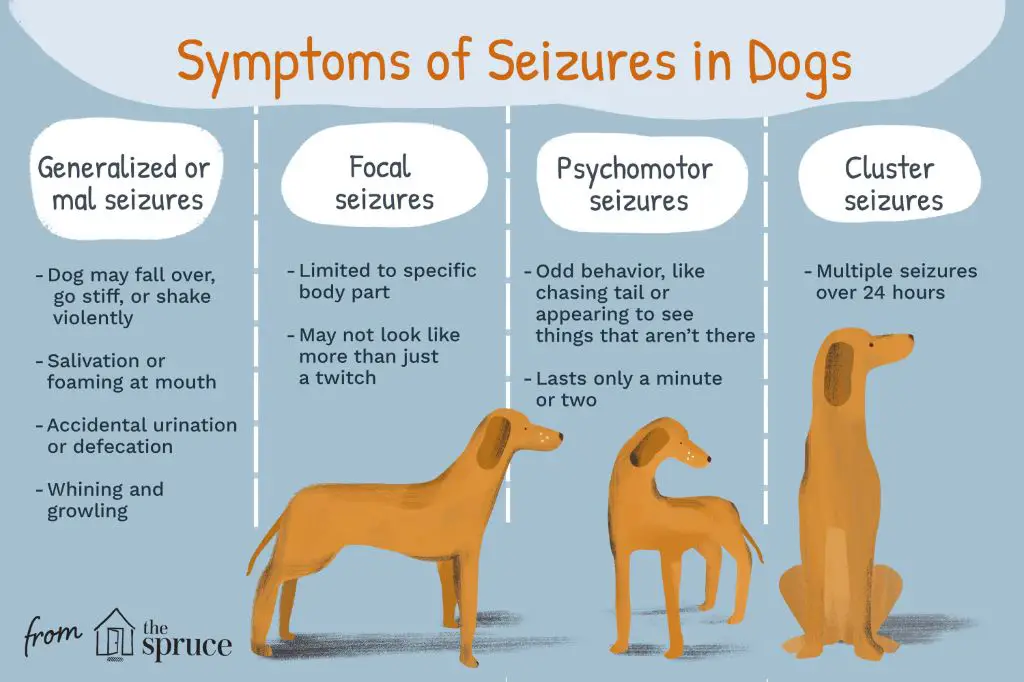Introduction
Seizures in dogs can be a frightening and difficult experience for both pets and their owners. A seizure occurs when there is sudden abnormal electrical activity in the brain, which causes involuntary muscle movements and possible loss of consciousness. Seizures may be isolated incidents, but they can also signal an underlying neurological disorder or brain tumor.
For dogs diagnosed with chronic, recurring seizures, caring pet parents face an agonizing decision: when is it time to let go? There is often no definitive point where euthanasia becomes the most humane option, but assessing your dog’s quality of life and the impact of seizures can help guide your decision. Ultimately, you want to balance allowing your dog to live joyfully with minimizing any suffering from uncontrolled seizures. With compassion and the guidance of your veterinarian, you can make the choice that is right for both you and your beloved pet.
Types of Seizures in Dogs
Dogs can experience two main types of seizures: focal and generalized.
Focal seizures (also called partial seizures) only affect one part of the brain and one side of the body. The dog will remain conscious but may display strange behaviors like lip smacking, wandering, or whining. They may turn their head or blink their eyes repeatedly. Focal seizures usually last less than 2 minutes.
Generalized seizures involve the entire brain. The dog will lose consciousness, fall over, extend their limbs rigidly, chomp their jaws, salivate heavily, and sometimes lose control of their bladder or bowels. The seizure usually lasts 1-3 minutes and is followed by a post-ictal period where the dog appears disoriented or lethargic while recovering.
Identifying whether your dog is having focal seizures or generalized seizures can help the vet determine the cause and best treatment options.
Causes of Seizures
Seizures in dogs can be classified as either idiopathic or secondary. Idiopathic seizures have no identifiable underlying cause and are believed to be genetic in origin. These types of seizures usually begin when a dog is between 1 and 5 years old. Secondary seizures are caused by an identifiable health condition affecting the brain. Some underlying causes of secondary seizures include:
- Metabolic issues like low blood sugar, kidney disease, electrolyte imbalances
- Head trauma or brain tumors
- Exposure to toxins like lead, organophosphates, or metaldehyde
- Infections like encephalitis, meningitis, or parasitic infections
- Vascular issues like strokes or brain bleeding
- Liver disease
- Brain inflammation

Determining whether a dog’s seizures are idiopathic or secondary is important, as the underlying cause will determine the course of treatment. Diagnostic tests like bloodwork, urinalysis, MRI, and CT scans may be needed to identify potential causes of secondary seizures.
Diagnosing the Cause
Figuring out what’s causing your dog’s seizures is critical for determining the right treatment plan. Your vet will perform a complete physical exam and ask about your dog’s medical history. They’ll want to know details about the seizures like when they started, how long they last, what your dog does before/during/after a seizure, and how frequent they are. This info helps categorize the seizures.
Your vet will likely run blood tests to check for things like liver or kidney disease, electrolyte imbalances, and infections which could trigger seizures. They may also recommend brain imaging tests like an MRI to look for tumors, inflammation, or structural problems. A spinal tap is another possibility to analyze the fluid and cells surrounding the brain and spinal cord. These tests give your vet the big picture to diagnose conditions like epilepsy, encephalitis, metabolic disorders, etc. Catching the cause early is key to treat it effectively.
Treatment Options
There are several treatment options available for dogs with seizures. The most common is anti-epileptic medication prescribed by a veterinarian. Commonly prescribed medications include phenobarbital, potassium bromide, zonisamide, and levetiracetam. The goal is to find the lowest effective dose with the fewest side effects. It may take some trial and error under a veterinarian’s guidance to find the right medication and dosage for an individual dog.
Certain diet changes may help, especially for dogs with idiopathic epilepsy. Diets high in good fats like omega-3s can help reduce inflammation in the brain that may be contributing to seizures. Consulting with a veterinary nutritionist may be beneficial.
For dogs with structural brain abnormalities or a brain tumor causing seizures, surgery may be an option to remove the lesion. An MRI allows veterinarians to visualize the brain and determine if surgery could help.
Other therapies like acupuncture, chiropractic adjustments, or natural supplements may help some dogs with seizures. Checking with a holistic vet for additional integrative treatment options may be beneficial.
It’s important to work closely with your veterinarian to determine the right treatment plan for your dog’s specific condition and needs.

Monitoring and Lifestyle Changes
Once your dog has been diagnosed with seizures, it’s important to closely monitor their condition and make adjustments to their lifestyle as needed. This can help reduce the frequency and severity of seizures.
Keep a seizure diary to record details such as date, time, length, symptoms observed, and any potential triggers. Share this information with your veterinarian to help determine patterns and appropriate treatment. Track their seizures using a calendar or app.
Take notes on any behavioral or physical changes before, during, or after a seizure. This may provide clues about triggers to avoid.
Some potential seizure triggers to watch for and minimize include:
- Stress and anxiety
- Lack of sleep or irregular sleep patterns
- Flashing or flickering lights
- Loud noises
- Strong scents and perfumes
- Sudden changes in temperature or weather
- Over-stimulation and excitement
Make the environment as relaxing as possible by playing soft music, maintaining routines, and avoiding overexertion during high-risk periods. Keeping seizures under control is key to preserving your dog’s quality of life.

Impact on Quality of Life
For dogs suffering from chronic or worsening seizures, the condition can significantly impact their quality of life. Some of the ways seizures affect dogs include:
- Increased frequency – Dogs may start having seizures more often, sometimes multiple times per day or week. This can be very disruptive and distressing.
- Clustering – Dogs may start having seizures in clusters, where they have multiple seizures within a 24 hour period. This can be extremely dangerous.
- Injuries – Dogs may injure themselves during seizures from thrashing around. Common injuries include head trauma, cuts, broken teeth, and torn nails.
- Post-ictal period – After a seizure, dogs enter the post-ictal period where they are disoriented and tired. This period may last from minutes to hours.
- Medication side effects – Anti-seizure medications can cause side effects like sedation, increased appetite and thirst, and liver problems.
- Shortened lifespan – Uncontrolled chronic seizures may shorten a dog’s lifespan.
As seizures take their toll, dogs may start to seem like a shadow of their former active, happy selves. Quality of life is drastically reduced when seizures dominate their health and wellbeing.
Signs It May Be Time
Deciding when to euthanize a dog with seizures is a heartbreaking decision every owner dreads. While there are some cases where seizures can be managed for years with medication and lifestyle adjustments, other times the condition worsens and significantly impacts quality of life. There are several signs it may be time to consider euthanasia:
Severity of seizures – If seizures last more than 5 minutes or become progressively worse, causing severe distress, injury, or your dog to lose consciousness for prolonged periods, it likely indicates the condition is advancing. Cluster seizures that come in groups with little recovery time in between are also concerning.
Frequency increasing – Most veterinarians become alarmed if unprovoked seizure activity occurs more than once a month, as this signals a worsening condition. If medication is unable to reduce the frequency, it may mean euthanasia should be considered.
Treatment resistance – If your dog continues having breakthrough seizures despite being on the maximum dose of anticonvulsive medication with blood levels in the therapeutic range, the seizures are likely refractory to treatment. Continuing seizures could then negatively impact quality of life.
Making the Decision
Making the decision to put your dog down is extremely difficult and filled with emotions. It’s important to thoughtfully consider if it’s the right choice for you and your pup.
First, consult with your veterinarian. They know your dog’s medical history and can provide perspective on her quality of life, prognosis, and whether her condition is treatable. Have an open and honest dialogue with your vet about your concerns. Ask questions and understand all factors involved.
Take time to realistically assess your dog’s day-to-day quality of life. Is she still able to enjoy the things she once loved? Is she suffering or in constant pain? Have the seizures become very frequent and severe? Take notes on her good days versus bad days. The goal is focusing on your dog’s comfort and wellbeing, not prolonging life just for your own sake.
Also consider your own ability to properly care for a dog with chronic health issues. Are you realistically able to provide all the medical treatment, supervision, and lifestyle adjustments required? Be honest with yourself. It’s a major commitment that affects your life too.
Making this decision is extremely difficult emotionally. But sometimes it’s the final act of love we can offer our furry friends. Focus on celebrating the wonderful life and memories you shared rather than dwelling on the sadness of loss.
Coping with Loss

Losing a beloved pet like a dog is one of the most difficult experiences. While the grief can feel overwhelming, remember to focus on the positive memories and the joy your dog brought to your life. Reflect on your favorite stories and quirks that made your dog special. Looking back at old photos and videos can help you remember your dog at their happiest.
Also make sure to practice self-care during this time. Get together with family and friends who understand what your dog meant to you. Consider reaching out to a pet loss support group, either locally or online. Take time to process your emotions and don’t feel rushed to “get over” your grief quickly. With time, the sadness will ease, leaving you with fond memories of the pawprint your dog left on your heart.